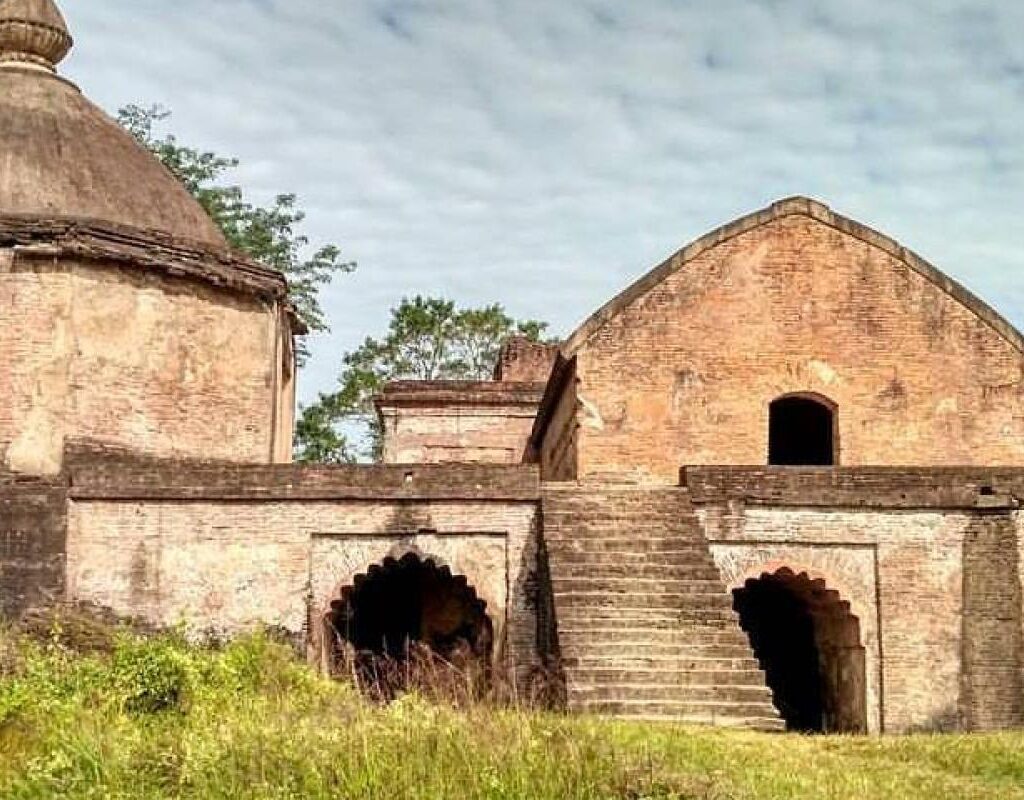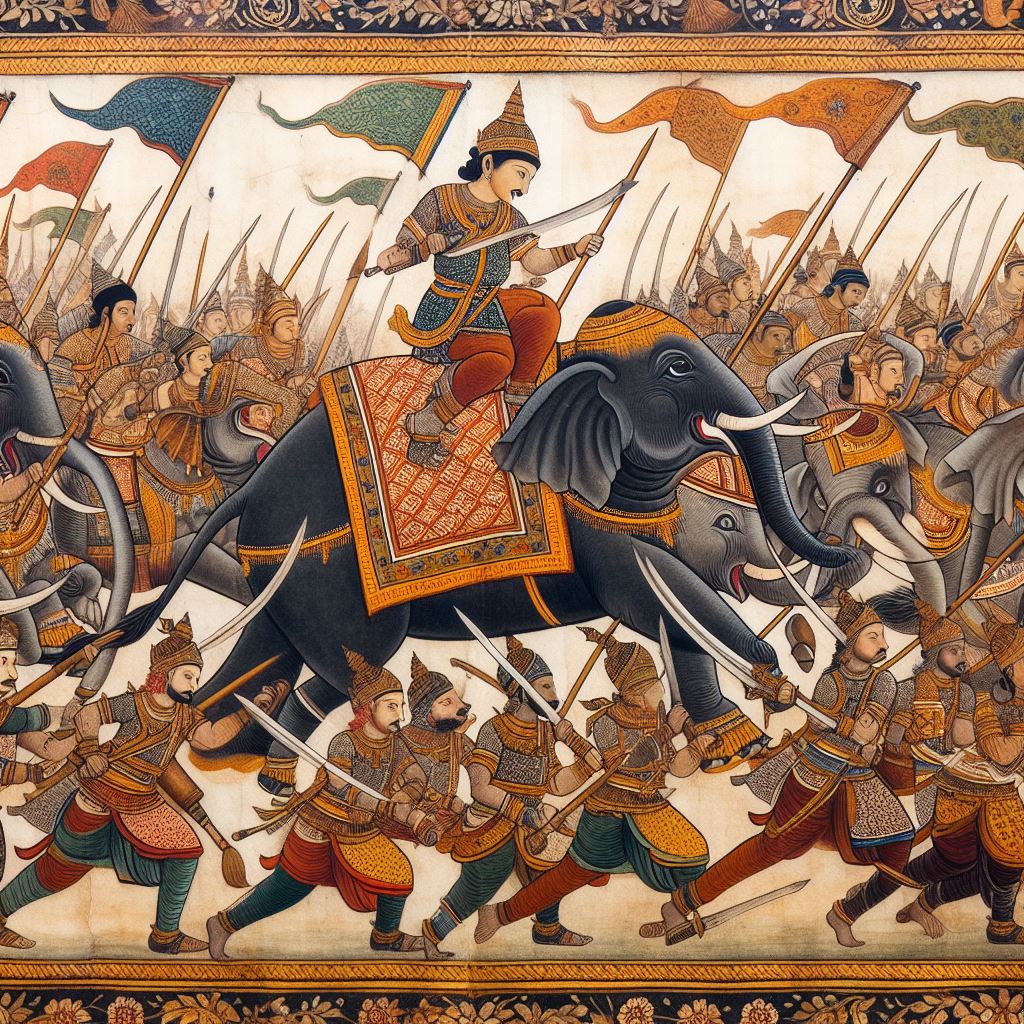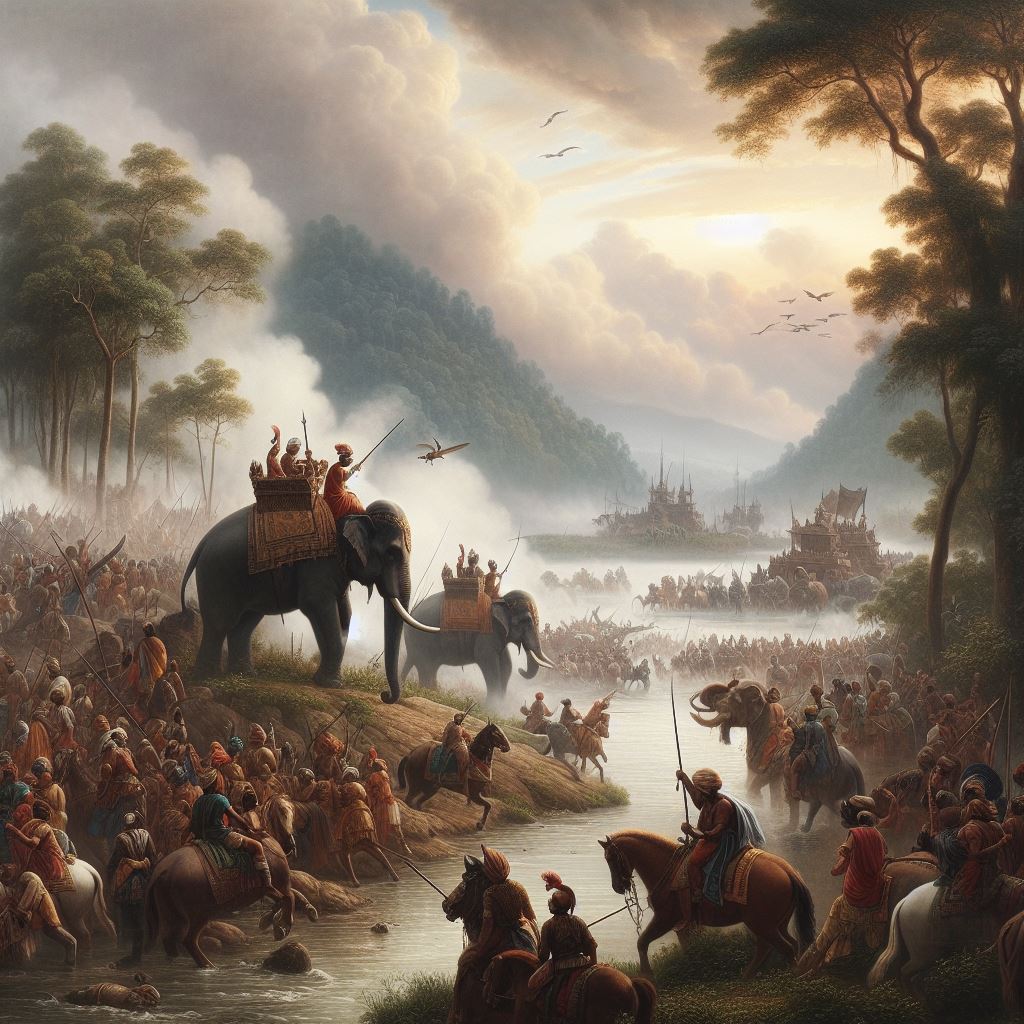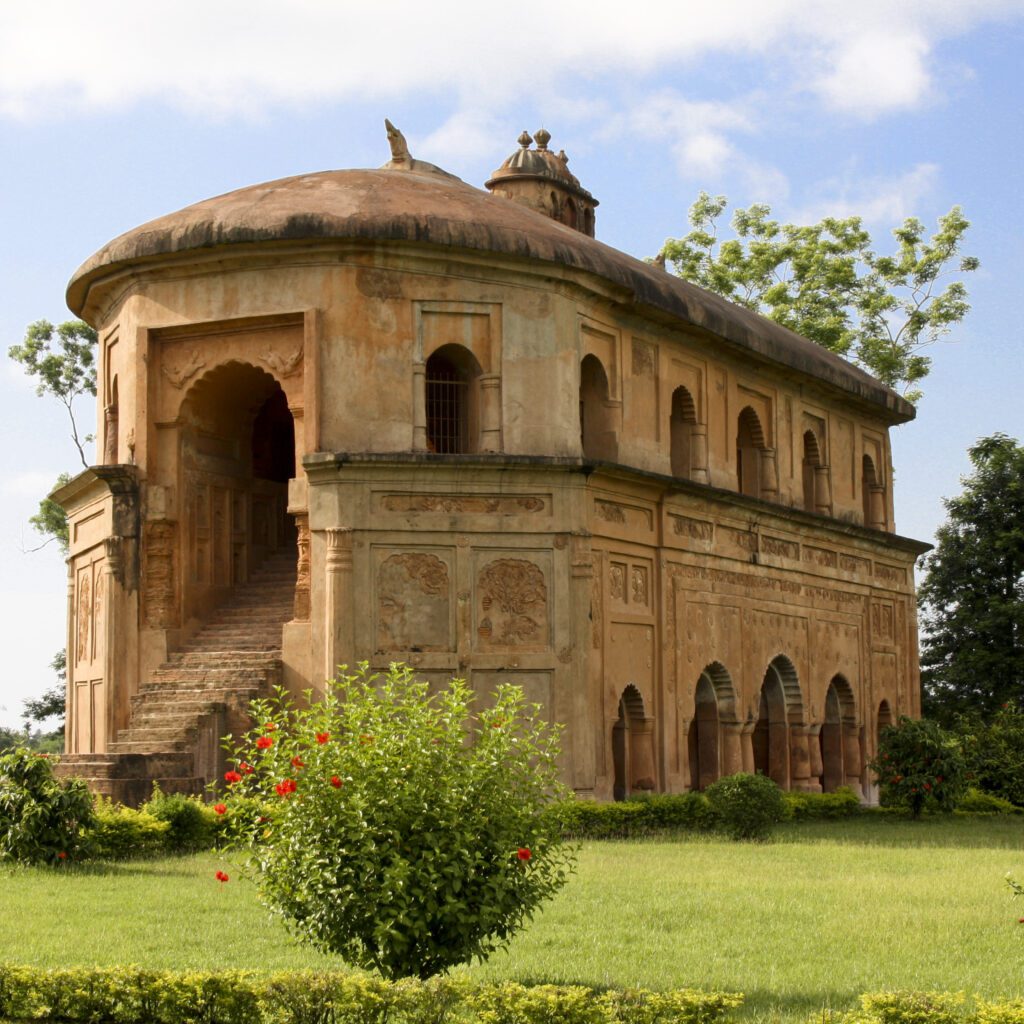Table of Contents
Ahom Dynasty: A Glimpse into Assam’s Rich Heritage
The Ahom dynasty, known for its rich history and cultural heritage, flourished in the northeastern state of Assam, India, from the 13th to the 19th century. This mighty dynasty played a significant role in shaping the region’s political, social, and artistic landscape. From its genesis in the 13th century, under the leadership of Chaolung Sukaphaa, to its decline in the face of external invasions, the Ahom dynasty left an indelible mark on Assam’s heritage.
In this blog, we will delve into the fascinating world of the Ahom dynasty, exploring its rise, expansion, notable monarchs, administrative structure, economy, daily life, military prowess, and enduring legacy in modern-day Assam. Join us on a journey through time as we uncover Assam’s rich heritage shaped by the remarkable Ahom dynasty.
Understanding the Ahom Dynasty

The Ahom Dynasty, situated on the south bank of the Brahmaputra River, is a great place to explore Assam’s rich heritage. This dynasty, with its roots tracing back to the Mahabharata, ruled for an impressive 600 years. King Chakradhwaj Singha was a prominent ruler, known for his contributions to the region, including the construction of the iconic city of Guwahati. The Ahom Dynasty faced several challenges, including conflicts with the Burmese King Bodoupaya, which led to the loss of significant territories. Despite this, their legacy endures, spanning over 600 glorious years.
The Ahom Dynasty Genesis
The genesis of the Ahom dynasty traces back to the establishment of the kingdom by the first Ahom king, Sukaphaa. The dynasty flourished, reaching its pinnacle during the 16th century, and brought about significant transformations in the region. This rise had a profound impact on the tribal communities of upper Assam, integrating them into the fabric of the kingdom. The Ahom rulers also played a pivotal role in integrating art forms and trade routes with Southeast Asia, establishing the region as a great place of cultural and economic significance.
Their influence extended across the south bank, with Guwahati being one of the prominent centres. The rich history of the Ahom dynasty is intertwined with tales from the Mahabharata and legends of Vishnu, reflecting the deep-rooted heritage of the dynasty. Notably, the reign of King Chakradhwaj Singha saw remarkable developments, while encounters with Burmese King Bodoupaya shaped the kingdom’s history.
The Ahom Dynasty Expansion and Flourishing Period
During the Expansion and Flourishing Period of the Ahom dynasty, the kingdom’s reach extended to Arunachal Pradesh and beyond, solidifying its influence in the region. The royal court played a pivotal role in governance, contributing to the kingdom’s stability and growth. Notably, King Chakradhwaj Singha led successful military campaigns, further expanding the kingdom’s dominion.
However, this period also saw the rise of threats from Mughal forces to the west, challenging the dynasty’s authority. Despite these challenges, King Pratap Singha successfully expanded the kingdom south of Brahmaputra, establishing the Ahom dynasty as a force to be reckoned with in the region. This era marked a significant chapter in the history of Assam, shaping it into the great place it is known today.
Memorable Kings of the Ahom Dynasty
The Ahom Dynasty was home to several memorable kings who left a lasting impact on Assam’s rich heritage. One of the renowned kings, Chakradhwaj Singha, shifted the kingdom’s capital from Sibsagar to Guwahati on the south bank of the Brahmaputra River, marking a significant era in the dynasty’s history. Another noteworthy figure, Burmese King Bodoupaya, attacked Assam but faced a great defeat due to the Ahom army’s valour. The Ahom Dynasty also has connections to the Mahabharata, with the belief that the name “Ahom” originated from the word “Ahom” in the Mahabharata. These kings not only strengthened the kingdom but also made it a great place of historical and cultural significance, leaving a legacy that continues to inspire generations.
The Remarkable Reign of Chaolung Sukaphaa
The founding of the Ahom Dynasty by Chaolung Sukaphaa, a Tai prince who migrated from the Yunnan province in China, marked the beginning of an extraordinary era. The dynasty’s rituals included significant participation in animal sacrifice, reflecting the cultural and religious beliefs of the time. In the 18th century, the Ahom kingdom faced a formidable challenge when the Burmese king, Bodoupaya, launched an attack, leading to a period of upheaval.

Despite these challenges, the dynasty’s rise brought about substantial changes in the region, shaping its history in profound ways. Notably, Ahom king Shiva Singha played a crucial role in furthering the dynasty’s legacy, leaving an indelible mark on Assam’s rich heritage. From the south bank to the city of Guwahati, the Ahom Dynasty’s reign created a great place intertwined with historical significance, spanning across kilometres and evoking connections to ancient tales like the Mahabharata and the legacy of Vishnu.
Other Noteworthy Ahom Monarchs
The influential Ahom monarchs were instrumental in the advancement of rice cultivation and trade, contributing to the dynasty’s economic prosperity. Through strategic alliances with various tribal communities, the rulers of the dynasty ensured the stability and expansion of their kingdom. Notably, King Suhungmung played a pivotal role in the territorial growth of the Ahom dynasty, leaving a lasting legacy in the history of Assam.
The decline of the Ahom dynasty marked a significant turning point in northeast India, leading to transformative changes in the region. The extraordinary military prowess of the Ahom rulers was integral in safeguarding their kingdom from external threats, including the invasion by the Burmese King Bodoupaya. These remarkable leaders and their contributions have immortalized the Ahom dynasty as a great place in the annals of history.
The Administrative Structure Under the Ahoms
The Ahom dynasty had a unique administrative structure that was well-organized and efficient. The king, Chakradhwaj Singha, reigned from the capital in Garhgaon, located on the south bank of the Brahmaputra River. The administrative setup also included the establishment of Guwahati, strategically positioned to control the westward expansion of the kingdom. The distance between Guwahati and Garhgaon was approximately 120 km, allowing for effective governance across the territory.

The administrative policies of the Ahoms were influenced by the Mahabharata and the veneration of Vishnu. Furthermore, the Ahoms successfully defended their kingdom from Burmese invasions, particularly under the rule of King Bodoupaya, showcasing their strategic prowess. This period witnessed the consolidation of the Ahom kingdom as a great place of power and influence in the region.
Roles and Responsibilities of Dangarias
The pivotal roles and responsibilities of the Dangarias within the royal court were essential for the functioning of the Ahom dynasty. Their administrative duties were crucial in maintaining the governance structure of the kingdom, contributing to the dynasty’s enduring legacy. Additionally, the Archaeological Survey of India’s extensive study has shed light on the rich heritage and cultural impact of the Ahom dynasty.
Rang Ghar, a significant monument, not only served as a royal pavilion but also functioned as a sports arena, reflecting the multifaceted nature of the dynasty. Furthermore, the Ahom dynasty’s contributions to astrology and syllabus have left a lasting imprint on the cultural and intellectual landscape of Assam. Jorhat, the capital of the Ahom kingdom, played a pivotal role in shaping the history and trajectory of the dynasty, making it a great place of historical importance in the South Bank region.
The Influence of Governors and Vassals
The rulers of the Ahom dynasty wielded considerable power, enabling them to make pivotal decisions that shaped the course of history. However, their authority faced a formidable challenge from the British East India Company, posing a significant threat to the sovereignty of the Ahom dynasty.
The succession of the Ahom throne adhered strictly to a patra system, ensuring a structured and orderly transfer of power. Moreover, the Ahom dynasty’s trade relations with the British East India Colony brought about substantial transformations, impacting Assam and the neighbouring regions of Manipur and Meghalaya. The influence of the Ahom rulers extended far beyond the south bank of the Brahmaputra River, leaving an indelible mark on the region’s history and heritage.
The Ahom Economy

The Ahom rulers strategically developed the economy by establishing trade relations with the Burmese King Bodoupaya and the south bank of the Brahmaputra River. They also implemented an efficient revenue system that helped in the economic growth of the kingdom. The Ahom kings, especially King Chakradhwaj Singha, played a significant role in enhancing economic prosperity. The kingdom’s connectivity to Guwahati, located just 25 km away, made it a great place for trade and commerce. The Ahoms also maintained a well-organized administration and contributed to the economic development of Assam. Their economic policies were influenced by the principles mentioned in the Mahabharata and were based on the concept of dharma as well as reverence for Vishnu.
Trade and Commerce in the Ahom Era
During the Ahom era, trade routes connected the kingdom to Southeast Asia, extending trade relations to China and Southeast Asia. Ahom rulers facilitated a thriving trade route through the Brahmaputra valley, crucial for the kingdom’s economy reliant on rice cultivation and trade. The Ahom kingdom played a significant role in trade and commerce in Northeast India, positioning it as a great place for commerce.
The strategic location along the south bank of the Brahmaputra River, near Guwahati, enabled the efficient movement of goods over long distances, with trade routes extending up to several kilometres. This historical significance is evident in the numerous references to the region in ancient texts like the Mahabharata, reinforcing its importance in the cultural and economic landscape. King Chakradhwaj Singha’s diplomatic ties with the Burmese king Bodoupaya further enriched trade relations, highlighting the kingdom’s influence on regional commerce.
The Unique Paik System
The professional class in the Ahom kingdom, known as the Paiks, held integral roles in maintaining law and order, reflecting the structured organization of the state. Their contributions were vital to the military strength of the Ahom kingdom, creating a great place for the state on the south bank. King Chakradhwaj Singha embedded the Paik system into the Ahom administration, with historical ties to the Mahabharata and Vishnu. The strategic location of Guwahati, just km away, also played a significant role, while the Paiks’ resilience was tested during the Burmese invasions led by King Bodoupaya. Their significance speaks to the rich heritage of the Ahom Dynasty, showcasing the enduring legacy of the Paik system.
Daily Life in the Ahom Kingdom

Life in the Ahom Kingdom was centred around the Brahmaputra River on the south bank, where the Ahom capital was located. The Ahom kings, including King Chakradhwaj Singha, contributed to making it a great place for trade and commerce. The kingdom’s proximity to Guwahati, about 20 km away, added to its strategic significance. The Ahom people revered gods from the Mahabharata and worshipped Lord Vishnu. Daily life in the kingdom was influenced by various cultural interactions, including those with Burmese King Bodoupaya, which further enriched the kingdom’s heritage.
The Rich Ahom Art and Architecture
The artistic and architectural legacy of the Ahom dynasty in Assam reflects a harmonious blend of Hindu and local styles, showcasing their cultural confluence. The main temple, a vital hub of art and culture, served as a testament to their artistic prowess. This dynasty’s significant contributions to Assam’s art and architecture are evident in historical monuments like Rang Ghar, which stand as a symbol of their architectural brilliance. The Ahom rulers’ patronage of art has left behind a rich and enduring artistic heritage, shaping the cultural landscape of the region. Their art and architecture continue to be revered, reflecting the greatness of this dynasty.
Cultural Practices and Occupations
The cultural practices of the Ahom dynasty were greatly influenced by the integration of tribal communities and the preservation efforts of the rulers. This integration played a key role in shaping the cultural landscape of Assam, while the Hindu religion also left a significant imprint on the dynasty’s customs and traditions. Furthermore, the kingdom thrived with various occupations such as trade and agriculture, contributing to the rich heritage of Assam. Notably, the Ahom dynasty brought about remarkable changes in the region, making it a great place of historical significance. The legacy of the Ahom dynasty continues to be an integral part of Assam’s identity, reflecting the amalgamation of diverse cultural elements and historical influences.
The Ahom Military Prowess
The Ahom rulers strategically positioned their capital in the eastern part of the kingdom, on the south bank of Brahmaputra. King Chakradhwaj Singha’s innovative military tactics were integral to the dynasty’s success. The Ahom kingdom was a great place for trade and commerce due to its geographical location. Guwahati, located just 60 km away from the Ahom capital, served as an important centre of trade.

The Ahom dynasty also had military encounters with Burmese King Bodoupaya in the late 18th century which changed the dynamics of the region. These military conquests were not only about expansion but also had a significant impact on the cultural landscape of the region mentioned in ancient Indian texts such as Mahabharata and Vishnu Purana.
The Guerrilla Warfare Genius
The mastery of guerrilla warfare tactics by the Ahom army proved to be a game-changer in pivotal battles, leveraging their profound understanding of the terrain for strategic advantage. Lachit Borphukan’s brilliance further amplified the success of these unconventional tactics, playing a vital role in defending the Ahom kingdom and securing significant victories. The expertise in guerrilla warfare was a defining factor in the triumphs that cemented the legacy of the Ahom dynasty as a formidable force in history. Their innovative use of guerrilla warfare techniques not only showcased their military prowess but also underscored their resilience in the face of formidable adversaries.
Notable Conquests and Conflicts
Throughout its reign, the Ahom dynasty’s military campaigns led to significant conquests, expanding its territory across the south bank of the Brahmaputra River. These conquests played a crucial role in establishing the Ahom kingdom as a great power in the region. However, internal conflicts occasionally tested the stability of the kingdom, posing challenges to its rule. The kingdom also faced external conflicts with neighbouring states and tribal communities, further shaping its military strategies and alliances.
Notably, the Ahom army’s conquest of upper Assam, including modern-day Guwahati, extended the kingdom’s influence and control, shaping the region’s history. Moreover, the Burmese invasion, led by King Bodoupaya, posed one of the most significant challenges to the Ahom dynasty, resulting in a decisive conflict that influenced the kingdom’s future.
The Decline of the Ahom Dynasty

The Ahom dynasty faced a multitude of challenges leading to its decline. Internal conflicts and external pressures played a significant role in this downfall. The kingdom’s confrontation with the East India Company and the Mughal Empire added to the mounting struggles. Furthermore, the rise of professional classes and internal conflicts weakened the dynasty from within. The political instability and the impact of external invasions further contributed to the disintegration of the once-great ruling power. Ultimately, the decline of the Ahom dynasty paved the way for the British East India Company’s influence in Assam, marking the end of an era for the kingdom.
Factors Leading to the Fall of the Ahom Empire
The fall of the Ahom Empire was influenced by various factors that altered the power dynamics in Assam and Northeast India. Internal conflicts within the kingdom weakened its ability to resist external pressures, while the incursions by the Mughal Empire further debilitated the Ahom state. Additionally, the rise of the British East India Colony and the end of a significant era in Assam’s history also contributed to the decline of the Ahom Dynasty.
This great place in history, with its roots in the Mahabharata and the reign of King Chakradhwaj Singha, saw a significant transformation due to these factors, ultimately marking a turning point for the region. The city of Guwahati, located on the south bank of the Brahmaputra River and with a history dating back to ancient times, played a pivotal role during this period, witnessing the transition and impact of the Burmese King Bodoupaya’s conquests in the region.
Influence of Ahom Dynasty on Modern Assam
The contributions of the Ahom Dynasty have left a lasting imprint on modern Assam, shaping its cultural, social, and political landscape. The Ahom rulers established their capital in the Ahom kingdom on the south bank of the Brahmaputra River, and their legacy can still be observed in the region today. King Chakradhwaj Singha, a devout follower of Vishnu from the Mahabharata, significantly influenced the religious landscape.

Furthermore, their resistance against the Burmese invasion by King Bodoupaya has immortalized their valour in history. Guwahati, once known as Pragjyotishpura, flourished under their rule, evolving into a great place of trade and commerce. Their remarkable architectural endeavours, including the construction of Rang Ghar, continue to draw visitors from far and wide, further underscoring their enduring influence.
Ahom Legacy in Contemporary Assam Culture
The enduring legacy of the Ahom Dynasty is evident in contemporary Assam culture through its art forms, architecture, and influence on literature. The royal court of the Ahom Dynasty played a pivotal role in shaping the art and literature of Assam, leaving behind a rich cultural heritage. The dynasty’s animal sacrifice rituals still hold significant cultural value in Assam, showcasing the lasting impact of their traditions. Additionally, the Ahom Dynasty’s influence on tribal communities in Assam further underscores their enduring legacy, displaying the widespread impact of their rule. Furthermore, the dynasty’s role in developing professional classes in Assam is a testament to their contribution to the socio-economic fabric of the region.
Ahom Contributions to Assamese Language and Literature
The cultural heritage of Assam was significantly enriched by the Ahom rulers’ patronage of Sanskrit and Assamese literature. Their support for astrology and religious literature left a lasting impact on the region, while their contributions to indigenous gods and goddesses hold great historical importance. Emphasizing the Assamese syllabus paved the way for educational development in the state, and their influence on the main temple architecture is a crucial aspect of their cultural contributions. The Ahom dynasty’s contributions to the Assamese language and literature are a testament to their great place in history, shaping the identity of Assam for centuries to come.
Conclusion
In conclusion, the Ahom Dynasty holds a significant place in Assam’s rich heritage. From its genesis to its flourishing period, the Ahom Dynasty witnessed remarkable reigns and notable monarchs. The administrative structure, economy, daily life, and military prowess of the Ahoms showcased their ingenuity and strength. However, like every empire, the Ahom Dynasty faced its decline due to various factors. Nevertheless, their influence on modern Assam is undeniable. The Ahom legacy continues to shape contemporary Assamese culture, language, and literature, and the unforgettable Ahom queen, Gaitondee, left an indelible mark on the dynasty. To delve deeper into history, check out our blogs for a fascinating read.
Faqs
Who is the founder of Ahom dynasty?
Chaolung Sukaphaa, a Tai prince who migrated from the Yunnan province in China, founded the Ahom kingdom in 1228 CE. He established the first Ahom capital at Charaideo near present-day Sibsagar.
Was Ahom a Hindu dynasty?
Initially, the Ahom rulers followed their indigenous religion and animistic beliefs. However, over time they assimilated Brahminical Hinduism. The Ahom kings built temples, patronized Hindu institutions, and took to Vaishnavite practices.
Who destroyed Ahom dynasty?
The Ahom dynasty declined after facing repeated Burmese invasions in the early 19th century. This weakened the Ahom state, paving the way for the annexation of Assam by the British East India Company after the Treaty of Yandabo in 1826.
Who was the most powerful king of Ahom dynasty?
Suhungmung, also known as Dihingia Raja, is considered one of the greatest Ahom rulers. During his reign from 1497 to 1539, the Ahom kingdom expanded greatly and faced victories against the Muslim Bengal Sultanate. He built a new capital at Rangpur.




